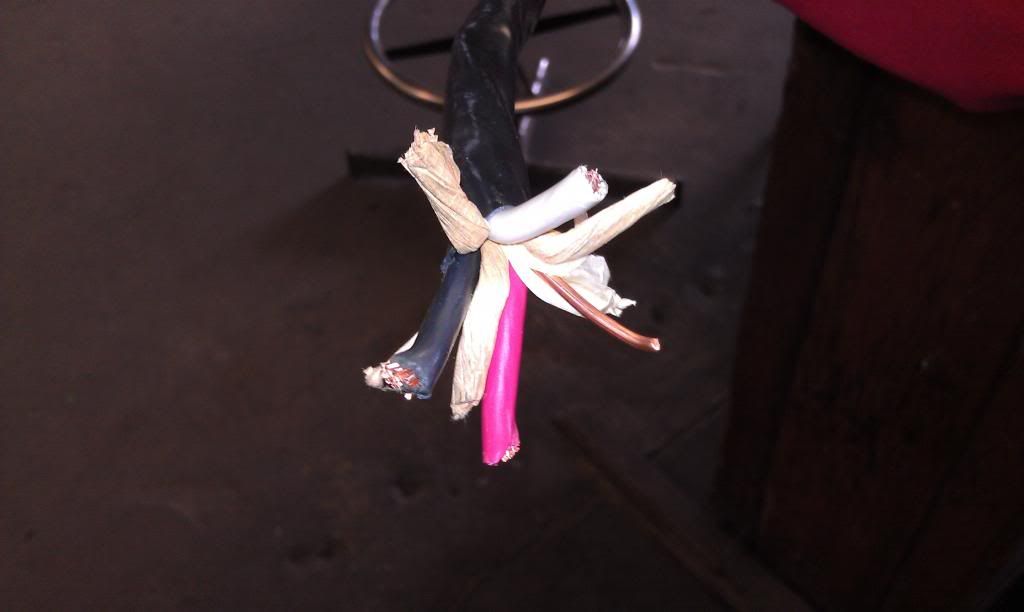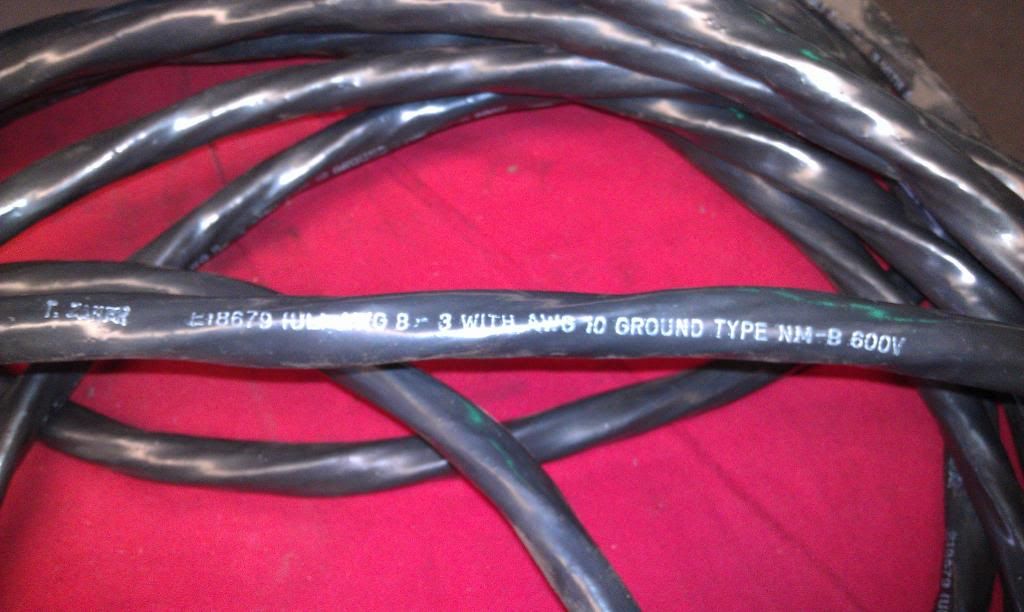Code question on burying wire.
verdigo
Solar Expert Posts: 428 ✭✭
Once upon a time there was a parts washer in my shop a couple of owners ago. Anyway. I had a new lift installed today, and used all but about 70 feet of some 240 volt three wire cable. Can I bury this cable in conduit and be code compliant? The two hot legs are 6 AWG and also has a bare copper solid wire. On the outside of the covering it says it is rated at 600 volts. If I seem ignorant about wire it is because I am.
Thanks
Dennis
Thanks
Dennis
Comments
-
Re: Code question on burying wire.
Its very vague what you are asking. Are these hot lines you want to bury and not use? -
Re: Code question on burying wire.
Friends of mine had to bury the leads from the Nova Scotia Power transformer pole, about 300 feet to their cottage - - because neighbors wouldn't give permission for installing power poles. It had to be done to code in NS, otherwise NSP wouldn't approve and connect. Had to be buried 3 feet below surface, and there had to be warning tape I believe (memory) one foot above the conduit, and another warning tape at 2 feet above. That way if in future years someone starts digging, they get two warnings before the sparks fly and the welding begins. Part of the trench required ripping through solid ledge, but they succeeded and all has been well for about 10 years now.
This may or may not be required in your area. -
Re: Code question on burying wire.
Is there any other numbers/letters/description on the outside of the exterior jacket of the wires?
Here is a UL PDF document that lists wiring types/classifications so you can see if you match the markings on the wire with the chart:
http://www.ul.com/global/documents/offerings/perspectives/regulators/electrical/newsletters/W&CMG_April2007_Final.pdf
Here is an example of basic direct burial cable:
http://www.aermotorwindmills.com/uf-direct-burial-cable.htm
There are many more classification of wiring types that you can even begin to guess at... Without the marking on the outer most jacket, I could not even begin to guess (generally, as I understand, direct burial non-metallic will be grey insulation and the three-4 wires will be fully contained in the extruded jacket (around each wire to keep out moisture--As opposed to normal jacket which will be a tube around the group of inner wires and buffer material). That is about the limit of my basic knowledge.
-BillNear San Francisco California: 3.5kWatt Grid Tied Solar power system+small backup genset -
Re: Code question on burying wire.Once upon a time there was a parts washer in my shop a couple of owners ago. Anyway. I had a new lift installed today, and used all but about 70 feet of some 240 volt three wire cable. Can I bury this cable in conduit and be code compliant? The two hot legs are 6 AWG and also has a bare copper solid wire.
It'll be fine as far as NEC is concerned in conduit, but only for 120V service for whatever you bury it to. USE (Underground Service Entrance) 240V split phase is four wire - two hots, neutral and ground. You can use three wire for 240V to appliances and electric motors, etc.. But not for underground service.
Edit:
I should note that 240V split-phase service has neutral and ground bonded at your main service entrance panel. Any 240V split-phase sub-panels wired into the service entrance panel have to use the 240V split-phase four-wire system, but neutral and ground is kept separate at the sub-panels. The sub-panels can be in the same building, or in out-buildings, and it doesn't make any difference.
You can bury the three-wire 240V split-phase system to electric motors like well pumps, irrigation pumps, or appliances like electric heaters or A/C systems, however, that do not have 120V sub-systems. If the appliance or device has a 120V sub-system (like an A/C unit with a 240V compressor and 120V fan motor on the condenser), then you have to use four-wire. The bare ground wire can never carry power except in the event of a ground fault.
--
Chris -
Re: Code question on burying wire.
Sorry, I missed the conduit part of the question--Won't the cable need to be rated for a wet location?
WIRING METHODS AND MATERIALS:
http://www.mikeholt.com/instructor2/img/product/pdf/1259687476sample.pdf
-BillNear San Francisco California: 3.5kWatt Grid Tied Solar power system+small backup genset -
Re: Code question on burying wire.ChrisOlson wrote: »It'll be fine as far as NEC is concerned in conduit, but only for 120V service for whatever you bury it to. USE (Underground Service Entrance) 240V split phase is four wire - two hots, neutral and ground. You can use three wire for 240V to appliances and electric motors, etc.. But not for underground service.
I don't know about the rules, but my service entrance used to be with USEB-2 3-wire cable - two aluminum hots and one reduced copper neutral wrapped around them. It is still sticking out where the pole used to be. This was installed in 1989 I believe, so rules might have changed. -
Re: Code question on burying wire.I don't know about the rules, but my service entrance used to be with USEB-2 3-wire cable - two aluminum hots and one reduced copper neutral wrapped around them.
No, that is legal and very common because your transformer center tap is grounded. 240V split-phase is three-wire distribution, but four-wire grounded. Service entrance panels with the three-wire entrance will have all the neutrals and grounds for all the circuits all going to the same neutral bus bar.
But you cannot use three-wire to another 240V split-phase sub-panel on that same service. See here for info on 240V split-phase four-wire systems:
http://en.wikipedia.org/wiki/Split-phase_electric_power
--
Chris -
Re: Code question on burying wire.Sorry, I missed the conduit part of the question--Won't the cable need to be rated for a wet location?
Bill, I'm pretty sure (without looking at the Code book) that wet location for underground means in direct contact with the earth. If it's in non-metallic liquid-tite conduit you can run Type NM underground if you want.
--
Chris -
Re: Code question on burying wire.
I actually don't think yo can run run of the mill NM in conduit buried...unless it is wet location rated. Conduit is seldomif ever water tight over time. The real purpose of the pipe is to protect the wire from digging etc. That said, there are plenty of NM UF wire out there.
Feel free to correct me if I am wrong,
Tony -
Re: Code question on burying wire.I actually don't think yo can run run of the mill NM in conduit buried...unless it is wet location rated.
Well, not regular old NM-B. But you can NM-C. Otherwise NM-C is not rated for underground use like Type UF. But if it's in non-metallic liquid-tite conduit you can use it for underground service.
Basically, you have to be close to a lawyer to figure out what you can get away with on NEC. For instance, THHN is only for dry location at 90C. But you can use it in wet location in liquid-tite conduit at the 75C rating.
I'm pretty sure electrical code and tax code were written by different lawyers that drink java at the same coffee house. LOL!
--
Chris -
Re: Code question on burying wire.
I guess my question would revolve around, "what is liquid tight"conduit? Conduit above grade, subjected to simple rain and snow may be pretty "liquid tight" but I have never seen glued PVC buried with above grade terminations stay dry for a long time. That said, my experience is somewhat limited.
I simply use UF.
T -
Re: Code question on burying wire.ChrisOlson wrote: »Edit:
I should note that 240V split-phase service has neutral and ground bonded at your main service entrance panel. Any 240V split-phase sub-panels wired into the service entrance panel have to use the 240V split-phase four-wire system, but neutral and ground is kept separate at the sub-panels. The sub-panels can be in the same building, or in out-buildings, and it doesn't make any difference.
Chris
It was a vague question. Sorry. I was thinking of using this for connecting to a sub panel in my shed. Too bad. Thanks for the info. -
Re: Code question on burying wire.
NM-B "Romex" 4-wire is fine for wiring up split-phase sub-panels. I checked, and as long as it is terminated inside a building it can be run in underground non-metallic PVC conduit with glued joints. If it is terminated in an outside panel, then it cannot be used and you'd have to use Type UF or NM-C.
--
Chris -
Re: Code question on burying wire.
Thanks. I need to do some reading on wiring interactive inverters.
Categories
- All Categories
- 233 Forum & Website
- 141 Solar Forum News and Announcements
- 1.4K Solar News, Reviews, & Product Announcements
- 199 Solar Information links & sources, event announcements
- 900 Solar Product Reviews & Opinions
- 256 Solar Skeptics, Hype, & Scams Corner
- 22.5K Solar Electric Power, Wind Power & Balance of System
- 3.5K General Solar Power Topics
- 6.7K Solar Beginners Corner
- 1K PV Installers Forum - NEC, Wiring, Installation
- 2.1K Advanced Solar Electric Technical Forum
- 5.6K Off Grid Solar & Battery Systems
- 429 Caravan, Recreational Vehicle, and Marine Power Systems
- 1.1K Grid Tie and Grid Interactive Systems
- 656 Solar Water Pumping
- 816 Wind Power Generation
- 624 Energy Use & Conservation
- 623 Discussion Forums/Café
- 315 In the Weeds--Member's Choice
- 75 Construction
- 125 New Battery Technologies
- 108 Old Battery Tech Discussions
- 3.8K Solar News - Automatic Feed
- 3.8K Solar Energy News RSS Feed


